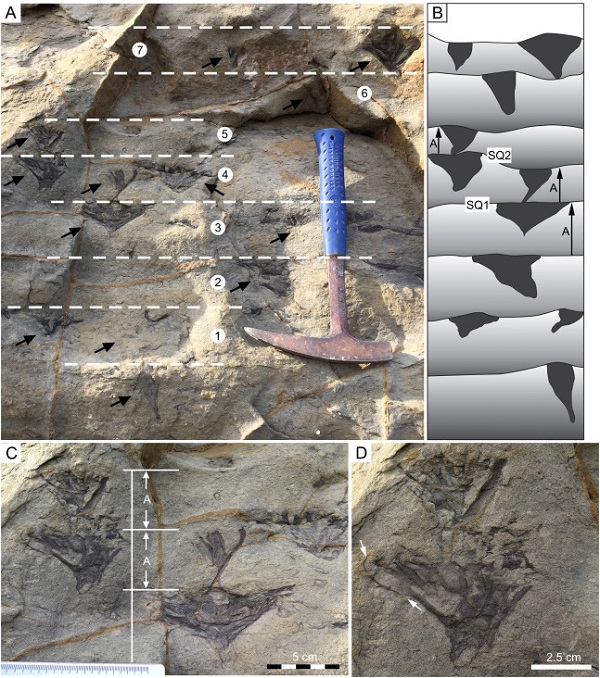Trace fossils are the behavioural records of ancient organisms, representing the archives of the interactions between organisms and their living substrates. As a special kind of fossil types, trace fossils may include trails, tracks, burrows and feces excreted by animals (coprolites).
The trace makers may include both skeletonized as well as soft-bodied organisms. Soft bodied organisms normally are seldom to be preserved as fossils. Hence trace fossils potentially provide more complete records of both infaunal and epifaunal organisms, thus facilitating the study of community structures and composition of ancient ecosystems. These characteristics make trace fossils as ideal agents to explore the evolution of early life on Earth, infaunal responses to environmental extremes during mass extinctions, palaeoenvironmental interpretations, and characterization and recognition of significant stratigraphical boundaries in petroleum geology.
Recently, Dr. LUO Mao from Nanjing Institute of Geology and Palaeontology , Chinese Academy of Sciences (NIGPAS) collaborated with Prof. SHI Guangrong and Dr. Lee Sangmin from University of Wollongong, Australia, had discovered a new trace fossil assemblage dominated by a potential bivalve trace (Parahaentzschelinia) from the Lower Permian Snapper Point Formation, which records deposition in a storm-influenced delta front environment. Related research results have been published in Palaeogeography Palaeoclimatology Palaeoecology.
The dense populations of Parahaentzschelinia trace occurred in two sections, forming stacked Parahaentzschelinia ichnofabrics. Researchers interpreted these ichnofabrics as equilibrium structures, which reflect the trace maker actively adjust their living positions in response to the shifted sediment-water interface, in seeking to remain in an optimal (equilibrium) living position with the local hydrodynamic and depositional conditions (e.g., increased sedimentation or periodic erosion).
The trace Parahaentzschelinia is an irregular, funnel-shaped burrow with multiple mud and sand-filled tubes radiating vertically or obliquely upward to the sediment surfaces. Distinct meniscate fills composed of alternating sand and mud laminae are characteristic of nearly all tubes, which are superimposed laterally and vertically. These dense, irregular funnel-shaped burrows may be produced by tellinid-like bivalves based on observations on the metabolic behaviour and burrow morphologies of modern tellinids. According to Dr. LUO Mao, the meniscate fills in Parahaentzschelinia isp. may be the result of successive movements of the siphons, leaving alternating sand and mud laminae.
Statistical analysis of burrow lengths and numbers of burrow adjustments suggests up to seven sequences of sediment accumulation events, supplying 3–13 cm thick clastic deposits at each time. A conservative sedimentation rate of 0.24 cm/year was estimated on the basis of two stacked Parahaentzschelinia ichnofabrics and the probable maximum lifespan of modern tellinid genus. This rate is generally comparable to those derived from modern deltaic environments, lending further support to the interpretation that the ichnofabrics were formed in and characteristic of a deltaic setting.
The research highlights the utility of stacked equilibrium structures as a sensitive indicator of certain depositional regimes, and its applicability for assessing sedimentation rates as well as depositional conditions in the geological past.
The research has been jointed supported by the Strategic Priority Research Program of Chinese Academy of Sciences, the CAS Talents Program, the National Natural Science Foundation of China, and an Australian Research Council.
Reference: Luo M*., Shi, G.R*., Lee, S., 2020, Stacked Parahaentzschelinia ichnofabrics from the Lower Permian of the southern Sydney Basin, southeastern Australia: Palaeoecologic and palaeoenvironmental significance. Palaeogeography, Palaeoclimatology, Palaeoecology 541, 109538. doi.org/10.1016/j.palaeo.2019.109538

Intergated section logs of the studied sections at Pretty Beach south (left) and O’Hara Island (right), which both represent the lower part of the Snapper Point Formtion in the southern Sydney Basin

Densely occurred Parahaentzschelinia from the section at O’Hara Island. A, Parahaentzschelinia isp. recording sequence of event sedimentation layers. Black arrows indicate individual Parahaentzschelinia isp.. B, Schematic artwork showing the re-adjustments of Parahaentzschelinia to episodic sediment deposition in A
